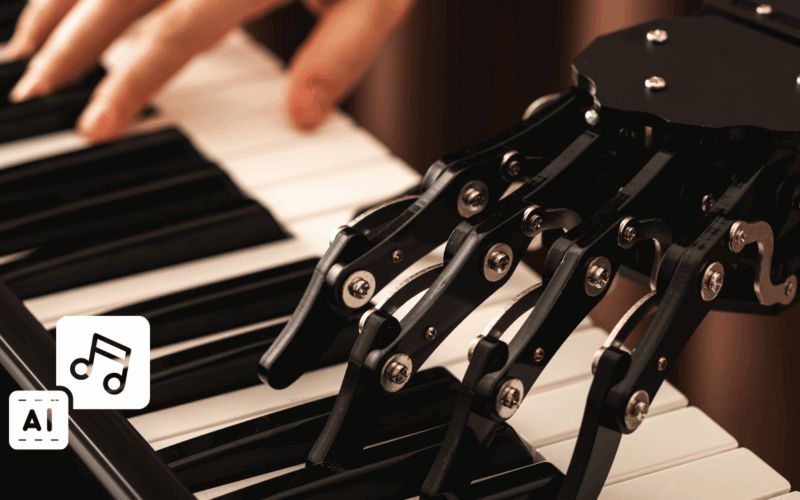Remixing is a creative conversation. You borrow an idea that moves you, you reshape it with your voice, and you send it back into the world as something new. Artificial intelligence does not replace that process, it multiplies it. With the right tools you can separate stems in minutes, detect key and tempo with confidence, audition grooves and textures, and sketch arrangements faster than ever. Use these powers with taste and with good ethics, and you will finish more remixes that sound like you. In this article, we’ll explore artificial intelligence (AI) music remixing as your guide to creating unique tracks with technological tools.
What a remix really is
A remix is a new arrangement or interpretation of an existing piece. You might keep the vocal and rebuild the harmony, you might slice a hook into a fresh rhythm, or you might design a new groove at a different tempo and feel. AI helps in four moments. It separates a mixed track into stems. So, analyzes musical information such as key, tempo, and structure. It generates new parts such as drums, bass, and pads. It assists with mixing and mastering so your track translates across speakers. None of that removes the need for genre literacy, good taste, and clean rights. It only removes friction, creating tracks with AI tools.
Legal and ethical basics
Remix on solid ground. Before you pull stems from any track decide what rights you have and where you plan to share the result. Work with material you own, with official remix packs, with licensed or royalty free stems, or with content that is clearly in the public domain. If you extract parts from commercial releases that you do not own, you will need permission for public release. Treat private experiments as practice. For anything public, get proper clearance, or choose licensed material that allows remixing. Laws differ by region, so when money or wide release is involved, ask a professional.
The AI remix toolbox at a glance: Music remixing guide
Use this table to map goals to tool categories. Specific product names change often, the categories stay useful.
| Goal in your workflow | AI or DSP category to use | What the tool does for you | What to watch for |
|---|---|---|---|
| Pull clean vocals or drums from a full mix | Source separation models | Split a stereo file into stems such as vocal, drums, bass, other | Artifacts on dense mixes, results depend on input quality and the model |
| Detect tempo, beat grid, and key | Music information retrieval analyzers | Estimate BPM, downbeats, and tonal center so edits stay musical | Verify with your ear, retap difficult live recordings |
| Generate new musical parts | Generative audio models and synthesis tools | Create drum patterns, bass lines, pads, or textures from prompts or MIDI | Use licensed prompts and your own MIDI, edit aggressively for fit |
| Style transfer and timbre morphing | Neural timbre transfer and harmonic modeling | Transform an instrument or voice into a new color without reperforming | Keep formants natural, avoid uncanny results on lead parts |
| Quick arrangement ideas | Composition assistants inside your workstation | Suggest chord reharmonizations and variations that match your key | Lock scale and key to avoid accidental modulations |
| Clean mix and release | AI assisted mastering and loudness targeting | Hit consistent loudness and peak ceilings for streaming platforms | Respect platform normalization targets, avoid over limiting |
A clean and ethical workflow from idea to final file
Think in five short passes. Each pass solves one job, and you will avoid getting stuck.
Pass one. Source and analyze AI music remixing
Collect stems you own or that you are licensed to remix. If you only have a stereo file and you have permission, run a separation model to extract a vocal or drums. Trim silence. Normalize lightly so analysis reads correctly. Detect tempo and key. Lock a grid in your workstation and pin a two bar count in at the start so edits stay aligned.
Pass two. Design the groove: Creating tracks with AI tools
Decide what the remix needs to feel like. Double time a ballad for the dance floor, or halftime a faster song for a deeper pocket. If you change tempo, stretch with a high quality algorithm so transients remain crisp. Replace the drum bed with your own kit or an AI generated sketch that follows your grid. Generators draft patterns quickly, yet they rarely land perfectly. Edit velocities, ghost notes, and fills so the pocket feels human.
Pass three. Harmony and hooks
Map the chord progression. If the original harmony is plain, try tasteful substitutions. Keep a stable path through the chorus so the vocal sits on confident tones. Generate or record a bass line that outlines the new harmony. If you need a pad or texture, audition an AI model for inspiration, then resample the result into a playable instrument so you can perform transitions and swells.
Pass four. Arrangement and energy: AI music remixing guide
Paint an energy curve. Intro, lift, drop, breakdown, lift, outro. Use mutes to reveal the hook rather than stacking layers forever. A simple trick works in any genre. Remove low frequencies before the chorus, then return them with impact on the downbeat. Automate reverb and delay sends so transitions breathe. When you borrow a phrase from the original, place it in a new context so the ear hears surprise along with recognition.
Pass five. Mix and master with translation in mind: Creating tracks with AI tools
Balance loudness against space. For streaming, aim near common normalization levels, and keep true peaks safely below zero to prevent intersample clipping. Translation matters more than raw loudness. Test on laptop speakers, phone speakers, and a car system. If the hook survives at low volume on small speakers, your balance is close.
How to get the most from source separation
Even strong models leave artifacts. Choose the right approach for the material. Models that specialize in drums and bass often outperform general models on those elements. If a vocal retains reverb from the original mix, feed the stem into a de reverb, then add a gentle gate to calm the tails. Layer your own doubles and harmonies so the focus shifts to new content rather than to small artifacts. When the original snare bleeds lightly into the vocal stem, carve a narrow EQ notch at the snare fundamental, then let your new snare occupy that space.
Prompt craft for AI generated parts
Treat prompts like directions to a session musician. Give genre, role, feel, and context. You want a bass line for a four on the floor house remix at one hundred twenty four BPM in A minor. Ask for a supportive line with syncopation that leaves space for the vocal in bars five through eight. For pads, request a warm sustained texture with slow attack and gentle movement, not a melody that competes with the singer. Provide a reference bar count and a clear key. The better the context, the better the draft.
Arrangement tricks that make remixes feel finished: AI music remixing guide
Silence is your most powerful effect. Drop the backing for a half beat right before the first downbeat of the chorus, the vocal will launch forward. Reverse a slice of the vocal to create a pre lift breath. Use call and response between a chopped hook and a new synth line. If you reharmonize the chorus, save the boldest substitution for the final pass so the journey feels earned. Resist the urge to reveal every idea at once. Let one surprise land, then move to the next.
Mix decisions that matter more than plugins creating tracks with AI tools
Level, panorama, and spectral balance make or break translation. Set a static mix before processing. High pass instruments that do not belong in the sub range. Keep kick and bass from fighting through arrangement first, then use sidechain as a gentle assist. When separation leaves a whisper of the old kick in the vocal stem, do not overcompress the whole vocal. Remove the narrow conflict and mask with a tasteful harmony line during exposed moments. Choose one focal point at a time. If the vocal carries the chorus, let the lead synth step back. If the synth owns the drop, thin the vocal and use it as texture.
For masters that land well on streaming platforms, you do not need to chase extreme loudness. Normalization will turn you down. Preserve transient punch, keep low end tight, and keep the top end smooth on earbuds. A slightly quieter master that feels open often beats a flat wall of sound once the platform adjusts levels.
Debugging the three most common problems: AI music remixing guide
The separated vocal sounds watery
This is usually phase smear and residual accompaniment. Restore presence with a transient shaper on consonants, add a gentle exciter for air, and mask short artifacts with your own harmonies or ad libs. If an artifact repeats every chorus, write a counter line that distracts the ear at that exact moment.
Your new drums fight the old groove: Creating tracks with AI tools
If a ghost of the original drums remains in the vocal stem, align your new snare to the old backbeat, or bury it with a complementary clap that lands just after. Microtiming repairs can turn a fight into glue. When in doubt, mute the ghost during fills and reintroduce it under steady sections.
Key detection seems wrong AI music guide
Busy vocals can trick analyzers. Confirm with the root movement in the bass and the melody tones at the top of each chorus. If a detector calls the track C major but the chorus centers on A, you may be in A minor. Correct the metadata in your project so every downstream tool behaves.
Release planning without headaches
Gather credits for every contributor. Keep proof of your license or permission to use any third party stems. Write clean metadata, including title, remix credit, composer and publisher information, identifiers, and artwork that reads well at small sizes. Decide where the remix belongs. If you do not have clearance, share only in private circles or keep it in your portfolio as a sample of your sound. Laws around sampling and derivative works are complex, so when in doubt, pick a different source or consult a professional.
Creative drills that build your signature
Remix a song you love in a contrasting genre using rhythm change and reharmonization only, no new melodies. Flip a hook into a call and response, the original line asks the question and your synth answers. Replace every drum with found sounds from your kitchen, then process them until they groove. Restrict yourself to one separation model for a week so you hear its habits, then switch to another and compare notes. The point is to train your taste, not to make the software famous.
A thirty day practice plan: AI music remixing guide
Days one to seven
Learn one separation method end to end. Build a small library of test stems, including clean vocals, dense mixes, and tracks with heavy ambience. Keep notes on which settings work for each case.
Days eight to fourteen
Create two grid locked edits at different tempos. Practice time stretching, beat aligning, and bar level edits so transitions land exactly on downbeats. Verify BPM with a second method and with your ear.
Days fifteen to twenty one
Write new rhythm sections under an a cappella. Use an AI generator only for sketches. Replace as much as possible with your own programming or playing so the track sounds personal. Save presets for drum bus, bass glue, and vocal polish that match your style.
Days twenty two to thirty
Mix and master three versions that translate on phone speakers, car systems, and studio monitors. Compare to a few reference tracks that share your genre and emotion. Adjust targets, then archive all project files with clear licensing notes so release day stays calm.
Final thoughts
AI makes remixing faster, not effortless. It gives you clean stems without a studio archive, previews keys and tempos in seconds, and proposes ideas when you are stuck. Your judgment still decides what belongs. Keep your workflow ethical, choose original or licensed sources, credit collaborators, and respect the people who inspired you. Build a repeatable process, keep a notebook of settings and discoveries, and measure success by the number of unique tracks you finish and share with pride. Treat AI like a set of sharp instruments, and treat your taste as the conductor, and every remix will sound unmistakably yours.








